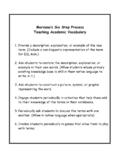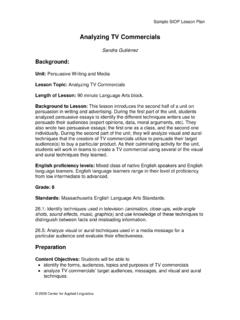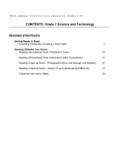Transcription of Science Graphic Organizers - actedu.in
1 Teacher Workbooks Graphic organizer Series Science Organizers Vol. 1. Copyright 2003. Teachnology Publishing Company A Division of Teachnology, Inc. For additional information, visit us at Table of Contents Comparisons Three Circle Venn Diagram 1. Venn Diagram 2. Comparing Concepts 3. Likenesses & Differences 4. Relationships 5. Comparing Scientists 6. Comparison Chart 7. Project Planning Controlled Experiment organizer 8. Division of Labor 9. Sightseeing organizer 10. Sorting organizer 11. Rock Hunting 12. Science Project organizer 13. Planning Chart 14. Group Plan 15. Cycles and Chains Cause & Effect 16.
2 Factors in the Cause 17. Four Stage Cycle 18. Six Stage Chain 19. Nine Stage Chain 20. Energy Pyramid 21. Science Vocabulary Science Vocabulary Builder 22. New Word 23. Meeting a New Word 24. Science Vocabulary Awareness 25. Science Related Word Matching Jigsaw Puzzle 26. Basic Science Organizers Layer organizer 27. Overview 28. Taxonomy organizer 29. This Week's Weather 30. Multiple Intelligence Lesson Plan 31. Scientists Biography 32. SQ3R Chart 33. iii Name _____ Date _____. Three Circle Venn Diagram Directions: Pick three topics to compare and list the individual characteristics for each topic in the circles that correspond with the topic.
3 Show where the topics share common characteristics in the overlap sections. Comparing: A. _____. B. _____. A A&B B. Overlap A, B, & C. Overlap A & C Overlap B & C Overlap C. 1. Name _____ Date _____. Venn Diagram Directions: For each element related to the main topic, write the individual characteristics that describe the element in each circle with characteristics that are similar in the overlap section. Main Topic: _____. A. Element or characteristic: B. Element or characteristic: _____ _____. A B. Similarities/Overlap 2. Name _____ Date _____. Comparing Concepts Directions: Use this compare/contrast organizer to explore analogous as well as non-analogous characteristics of two concepts related to a given topic.
4 Topic: _____. Concept 1: Concept 2: How are they alike? _____. _____. _____. How are they different? _____ _____. _____ _____. _____ _____. _____ _____. _____ _____. 3. Name _____ Date _____. Likenesses & Differences Directions: Use this organizer to show the relationship between two concepts. Concept 1: Concept 2: Different Same Different 4. Name _____ Date _____. Relationships Directions: For each concept, write how they are related. Concept 1: Concept 2: 5. Name _____ Date _____. Comparing Scientists Directions: Pick up to three but no less than two scientists to study. Complete each section.
5 Names Scientist 1 Scientist 2 Scientist 3. Time period: Best known for: Where did they study? History/background: Major achievements: Other pertinent information: 6. Name _____ Date _____. Comparison Chart Directions: Make a list of concepts. List various characteristics across the top that can apply to any of the concepts you picked. Check the boxes that apply to each concept. Characteristics . Concepts 7. Name _____ Date _____. Controlled Experiment organizer Directions: Use this organizer as a guide to conduct a controlled experiment. Title: Problem: Hypothesis: Procedure(s): Dependent Variable: Independent Variable: Control: Observation: Data: Conclusion: 8.
6 Name _____ Date _____. Division of Labor Chart Direction: Use this chart to keep assignments organized. Student Role Due Date(s) Responsibilities 9. Name _____ Date _____. Sightseeing organizer Directions: Take a sightseeing walk and list all of the significant landforms, animals, plants, and forms of pollution you see on your trip. Landforms Animals Plants Pollution 10. Name _____ Date _____. Sorting organizer Directions: Use this organizer to keep track of sorting. Total number of: _____. Total number of: _____. Total number of: _____. Total number of: _____. Total number of: _____. Total number of: _____.
7 Total number of: _____. Total number of: _____. Total number of: _____. Total number of: _____. Total number of: _____. Total number of: _____. Total number of: _____. Total number of: _____. 11. Name _____ Date _____. Rock Hunting Igneous Rock This type of rock is formed by molten mixtures of minerals and gases found within the Earth's surface called magma. As the magma cools, igneous rock is formed. Metamorphic Rock This type of rock is igneous, sedimentary, or metamorphic rock that has been changed by heat, pressure, or permeation by other substances. Sedimentary Rock This type of rock is formed by materials that have been deposited by the action of gravity, water, and/or wind.
8 Over time, the materials conform and harden. Directions: Go on a rock hunt and collect as many different types of rocks as you can find in your area and classify the types of rock below. Igneous Metamorphic Sedimentary 12. Name _____ Date _____. Science Project organizer Directions: Use this organizer to keep track of a Science project. Project ideas: Names of possible Start date: partners: Complete date: What will I need to complete project? Possible problems I might encounter: What must my project achieve? 13. Name _____ Date _____. Planning Chart Directions: Use this organizer to show a sequence of events that result from a specific action that is planned.
9 For each possible result, describe specific results that can occur. Possible Results Describe specific results. Planned Action 14. Name _____ Date _____. Group Plan Directions: Use this chart to help organize a cooperative learning activity. Materials needed: Goal(s): Group members and roles: Plan: Evaluation and due dates: 15. Name _____ Date _____. Cause & Effect Directions: Pick an event to explore or investigate and describe the effects of that event in the appropriate boxes. Cause Cause Cause Event: Effect Effect Effect 16. Name _____ Date _____. Factors in the Cause Directions: Choose an event and describe the factors that caused the event in the appropriate boxes.
10 Factor #1 Factor #2. Factor #6 Factor #3. Event Factor #5 Factor #4. 17. Name _____ Date _____. Four Stage Cycle Directions: Use this sequential organizer to illustrate a step by progression that results in a full cycle. 1. 4. 2. 3. 18. Name _____ Date _____. Six Stage Causal Chain Directions: Use this organizer to illustrate a causal chain resulting in a final outcome. 1. 2. 4. 3. 5. 6. 19. Name _____ Date _____. Nine Stage Chain Directions: Use this organizer to show a chain of events leading to an end result. 1. 2. 3. 4. 5. 6. 7. 8. 9. 20. Name _____ Date _____. Energy Pyramid Directions: Use this organizer to illustrate a hierarchal representation of a topic.




